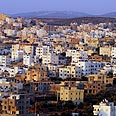
Arab-Israeli city of Taibe
Photo: Gilad Kawalarchik
Why is Israel's poverty rate amongst the highest in the world? This is one of the questions that was discussed by researchers ahead of next month's Caesarea Conference.
One standing assumption, of course, that Israel's soaring poverty rate is the result of a particular cultural mosaic that includes populations (Arabs and ultra-Orthodox) who conduct their lives according to social norms that differ from Western ones.
Israel has the highest percentage of Muslim citizens of any country in the Western world except Turkey. A quick glance at the statistics shows that that in relation to such terms as family size and participation in the work force, Israel's Arab population reflects similar trends as Muslims in neighboring countries such as Jordan and Egypt.
Sources of poverty
The combination of many children and few wage earners is a proven recipe for low income and for poverty. But are these really the main reasons for Arab poverty in Israel?
In order to answer this question, and in order to neutralize the affect of the low participation rates of Arab women in the work force, we measured average poverty rates amongst Jewish and Arab populations with similar proportions of wage earners.
The averages are amazing: The poverty level amongst the Arab community is significantly higher than the Jewish one, even when the number of wage earners is roughly the same. And the phenomenon repeats itself when comparing Arab and Jewish families with similar numbers of children.
Rampant discrimination
Anyone living here knows Israel's Arab population does not enjoy equal treatment. This discrimination exists on both the institutional and private levels, and can be found at just about every level of economic involvement. These levels determine a sector's success in this area.
Arabs face discrimination at the very first stage of creating human capital (education). So, for instance, class sizes in Arab elementary schools are more than 25 percent higher than in Jewish class rooms.
But the bias against Arab Israelis doesn't end there. It continues in the job market. Just imagine the reaction of a Jewish employer presented with two resumes – one presenting Mohammed from Taibe, the other Avi from Kfar Saba. It's easy to guess who'll be picked, even if the Arab applicant shows slightly better qualifications for the job.
This unfair competition finds expression in higher levels of unemployment and lower average wages for Arab workers. And according to official numbers released by the Central Bureau of Statistics, Arab workers earn about 20 percent less than Jews with similar levels of education working in similar positions.
These numbers do away with the claim that Arab poverty is mainly a result of cultural choice (large families and stay-at-home wives). The main reason for poverty is the basic lack of equal opportunity. Righting this wrong, and ensuring equal opportunity for Arabs in the work force must be a central ingredient for any long-range plans for fighting poverty in Israel.
Dr, Momi Dahan is a researcher at the Hebrew University of Jerusalem. His areas of research include Public Finance, Macroeconomics, and Income Inequality.















